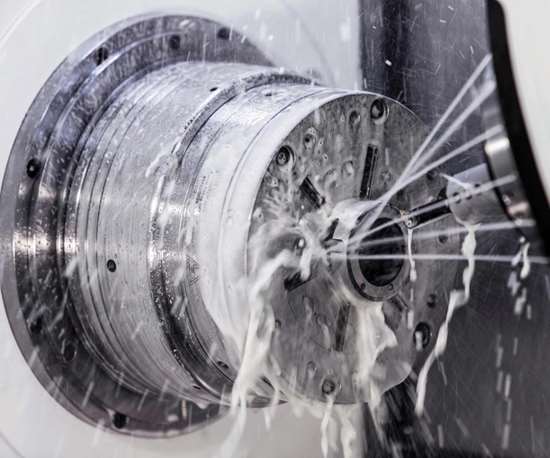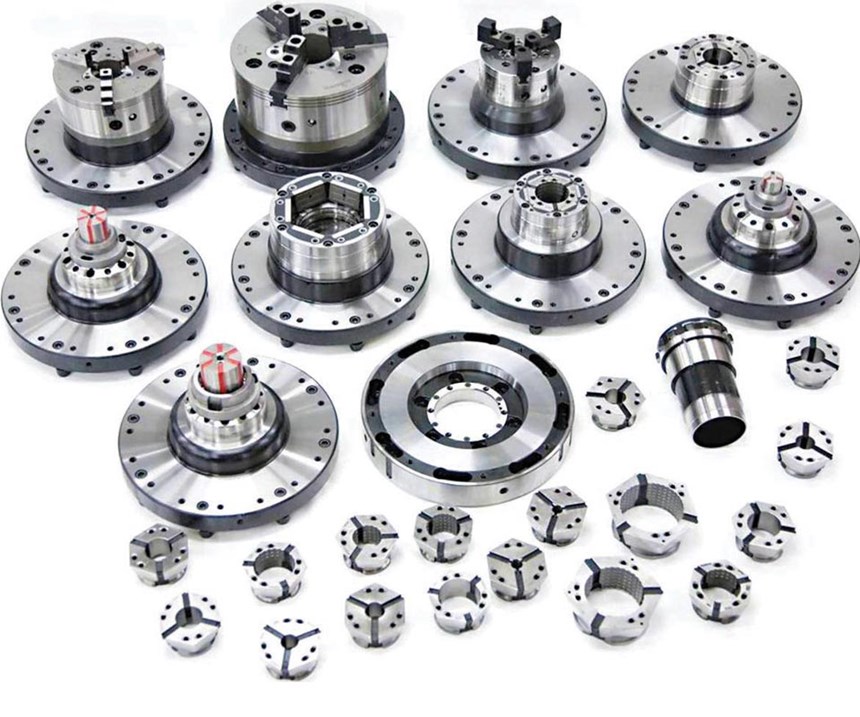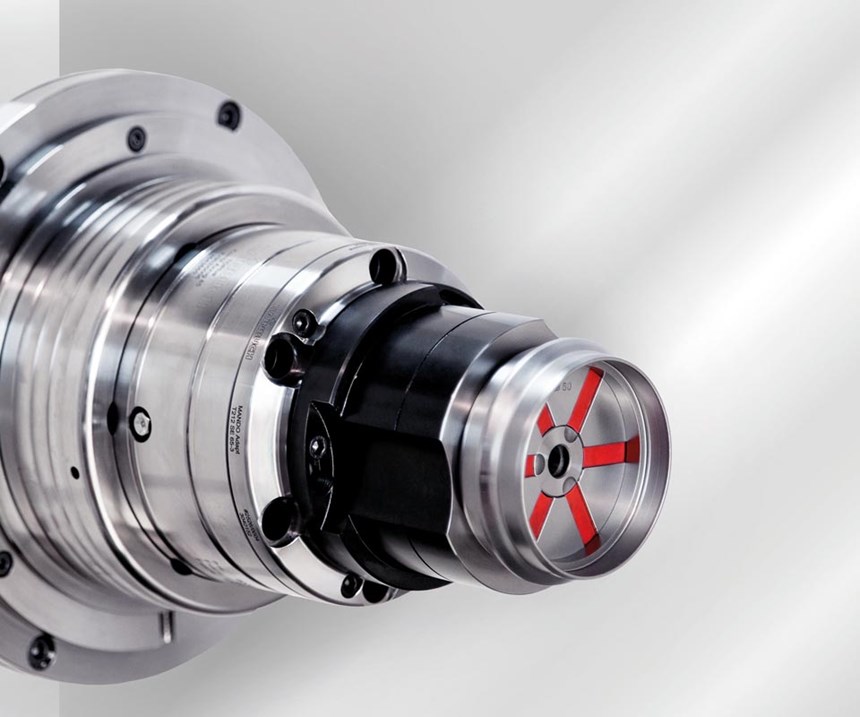Precision Workholding Delivers Accuracy and Production Capabilities
Holding the workpiece precisely is becoming an integral aspect of the machining process. It's more than presenting the blank to the cutter; it also includes repeatability from blank to blank.
#basics
The increasing demand for high accuracy machining of new, hard materials and the need for faster change-over in the production of multiple small to medium part quantities has sparked manufacturers’ interest in technologies that enhance machine performance. Among the available technologies, precision workholding has proven to be a versatile and powerful tool for a range of production requirements.
The last decade has seen an unprecedented upsurge in demand and, in response to our customers’ needs, the introduction of advanced products. According to James F. Woods, president of Hainbuch America Corp., the North American distributor for the products of Hainbuch GmbH, “Both OEMs and job shops have come to the realization that competing in manufacturing is, to some extent, like stock car racing: You start with the best basic machine you can find, but, in order to win you have to modify it with equipment that will elevate its performance.”
Featured Content
Some Workholding Solutions
The need for improved precision is especially acute in the area of rotational parts. The chucks or other standard workholding devices on conventional machines, including turning centers, Swiss-type machines and multi-purpose units featuring vertical or other axes, are mostly general purpose equipment designed to serve a range of applications and are not readily suitable for specialized precision or production needs. Further, as the machine’s single workholding component, they are subject to excessive wear and a corresponding loss of precision and repeatability.
Precision workholding systems, on the other hand, are designed and built to handle applications that fall within specific size ranges. In both ID and OD turning operations,
a Hainbuch chuck can accommodate collets and mandrels in multiple sizes so as to address any number of part families. In the Hainbuch system, Spanntop chucks are available in sizes ranging from 32- to 160-mm, and most applications can be accommodated using available clamping devices. Where necessary, the company can quickly design and build special sized units.
To ensure precision, chucks and clamping units are designed for user-friendly setup and parallel clamping. For clamping on the ID, Hainbuch’s Mando Adapt is a segmented mandrel design that includes specially formulated elastomers between the segments in order to avoid even the slightest damage to the workpiece.
In the Trenches
The successful machining of complex parts made from hard or exotic materials requires an optimized system, including the machine, the tooling and dependable workholding equipment. “From a production standpoint, though, it is equally important that the system be capable of fast change-over without sacrificing the required accuracy,” says Larry McMillan, Great Lakes area regional manager for Hainbuch. “Most of our customers choose systems for their flexibility, ease of reconfiguration, and dependable repeatability over multiple part sizes and families.”
While standard chucks or other workholding systems can require extensive and time consuming setups, advanced precision workholding systems are designed to quickly and easily convert from one clamping device to another. Even when part size differences require the removal and replacement of the chuck, the mounting system assures a quick and accurate replacement without the necessity of adjustments.
An example of the need to combine higher production capabilities in precision manufacturing can be found at CMMG, a Fayette Missouri-based manufacturer of AR-15 rifles, 22LR AR-15 conversion kits and accessories.
A particularly critical operation involves the machining of gun barrels that the company produces in nine different calibers and in sizes ranging from 4.5 to 24 inches in length. Because of workholding problems, the company’s speeds, feeds and depths of cut were not up to its standards, and insufficient clamping pressure caused chatter problems.
Realizing that problems would only multiply as production demands grew, CMMG management chose Hainbuch to help with its workholding efforts. “We evaluated CMMG’s needs based on its production goals and the material—a 4140 stainless or a 416 stainless chrome moly—that they were using and recommended a Spanntop Nova Combi deadlength model in the 65-mm size range. Tom Buraczewski, regional sales manager, says, “With this system, the barstock is fed through the center and then engages an end-stop.”
Once that occurs, the unit delivers the correct amount of pressure to maintain accuracy throughout the manufacturing operation. The scope of operations involves gripping, extracting and clamping, and the results were successful, even on an older lathe.
CMMG’s depth of cut went from 0.032 to 0.070 inch, and feed rates improved from 0.015 to 0.018 inch. Our surface feet per minute increased from 820 to 925, and pulling length deviation (three pulls of the same part) has gone from 0.010 to 0.001 inch. Also, our cutting tool life has been extended, and we use a specially designed end-stop that guarantees accuracy of length.” See “Learn More” on page 35 for the link to read this story in its entirety.
Making ‘Old’ New Again
Many shops own old workholding equipment that may not be as accurate as it once was. However, with retrofitting as an option, an old system can work like new or even better than the original system.
“More of our customers are discovering that retrofitting an older lathe with our system can deliver better accuracy and repeatability than the unit had when new, which represents a significant savings over the cost of a new machine, while at the same time providing better flexibility and faster change-over with accuracies of 6 microns, even when changing from OD to ID clamping,” Mr. Woods says.
The conversion from conventional workholding to the Hainbuch system goes beyond the installation of the devices and components. To fully use the advantages inherent with the system requires a change in approach that can impact both programmers and operators. Hainbuch’s research has revealed that up to four times the clamping pressure is available with ID workholding than conventional OD systems. In addition, the vulcanized fuller contact bushings in systems such as the Mando Adapt expose more of the workpiece than conventional clamps and allow as many as five “sides” to be machined in the same operation. This holds true for both rotational parts and prismatic workpieces machined on five-axis machining centers.
As industries shaping the future of technology continue to demand more complex parts and small to medium production runs, manufacturers and shops that serve them will increasingly opt for precision workholding systems.
“Our customers know that besides requiring the production advantages that precision workholding delivers, it is also one of the most cost-effective means of ensuring their competitive capabilities,” Mr. Woods says. “In many cases, the initial installation has proven so successful that additional machines have been similarly equipped. In fact, our new CentroteX system now enables customers to add precision machining and quick change-over to the manufacture of larger parts.”
Hainbuch’s CentroteX system is based on a machine adapter plate, equipped with coupling receptors, that is fitted to the lathe. The plate holds clamping device adapters in various sizes that attach to the coupling and are strengthened by rapid-action screws.
In the case of heavier clamping devices, the quick-change capability is aided by the Monteq mounting aid—an arc-shaped holder suspended from a spring-mounted attachment and equipped with quick-action bolts. A customized clamping device container on wheels is provided for clean and secure storage of the clamping devices.
A manufacturer of pressure-tight receptacles that protect temperature sensors in processing applications chose the CentroteX system to handle different size parts and meet high-precision tolerances in materials such as stainless and Inconel. CentroteX enabled the manufacturer to perform operations on one lathe instead of two with a change-over time of less than 5 minutes.
In another challenging application, a Midwest-based manufacturer of temperature sensing devices and equipment sought to improve change-over time in the production of high-precision thermowells—pressure-tight receptacles that protect sensors in hostile environments. The thermowells are tubular structures that are fabricated from materials including stainless steel, Inconel, Hastelloy, Monel, or other alloys and range from 2 to 36 inches topped by a 3- to 12-inch diameter flange. In the former manufacturing sequence, the tubular portion, which is tapered, was typically run in a collet chuck, after which the flange portion was completed on a larger three-jaw chuck. Initially, both operations were performed on a twin-spindle, twin-turret lathe, and the need for change-over between machines required a more extensive setup time. The use of the CentroteX system, equipped with the heavy-duty Monteq mounting aide, assured precision by eliminating the need for two machines and resulted in a change-over time of less than 10 minutes.
The “automation friendly” capability of precision workholding systems is demonstrated at a Michigan-based gear manufacturer active in the development of complex prototypes and production components for the automotive industry. Materials involved include case hardened or carburized 5120, 4320, and 8620 steels, induction hardened alloys and nitride 4140.
Initially, custom tooling required finishing part-holding diameters and faces to highly precise and consistent tolerances. Thanks to the expandable arbors from Hainbuch, consistent, high precision results are achieved without the need to over-machine part holding tolerances. Since acquiring the initial system, the company has similarly equipped all gear-making machines and developed a compatible tooling library to optimize the machining process.
“As manufacturing advances, we’re obliged to continually re-examine all related tools and components and, when it comes to metalcutting, workholding is a critical starting point,” Mr. Woods says. “By taking advantage of precision systems early on, both manufacturers and job shops can derive immediate benefits and, at the same time, prepare themselves for future automated operations.
“America’s manufacturing resurgence is largely due to our ability to handle complex parts with tight tolerances in exotic materials and to profitably produce small to medium size runs. Through our combination of high precision, modularity and fast change-over, we’re helping manufacturers retain that advantage in an increasingly competitive market.”
RELATED CONTENT
-
Understanding CNC Collet Chucks
Workholding for turning is usually fairly basic: The selection comes down to chucks or collets. This article looks at when to consider the collet chuck and what kind might be best for a given application.
-
Calculating Surface Footage and RPM for Optimum Tool Life
Tech Brief: Calculating Surface Footage and RPM for Optimum Tool Life
-
Making Micro Threads
Production of micro threads can be challenging, but using the most suitable tools for a given application can simplify the task.











